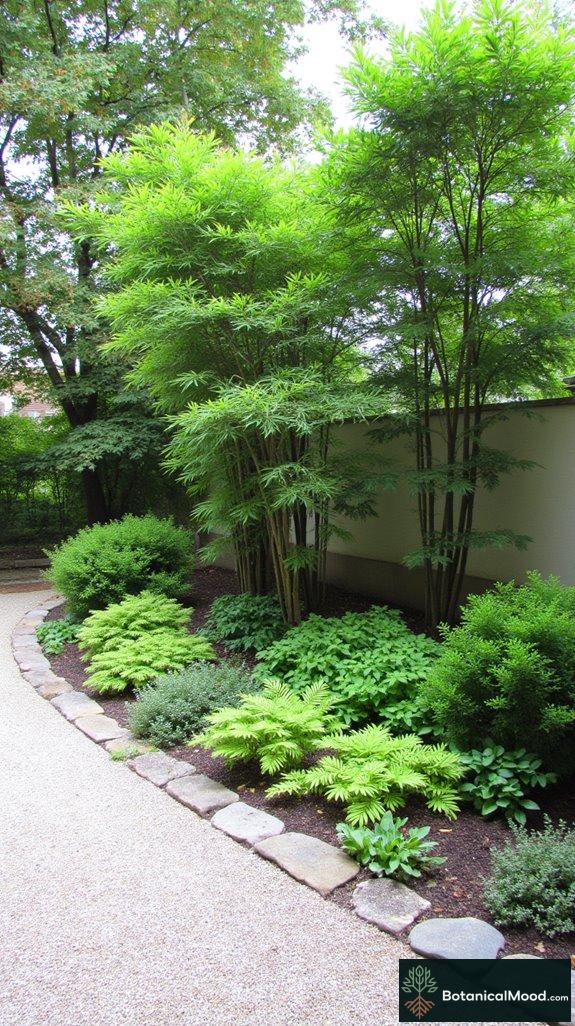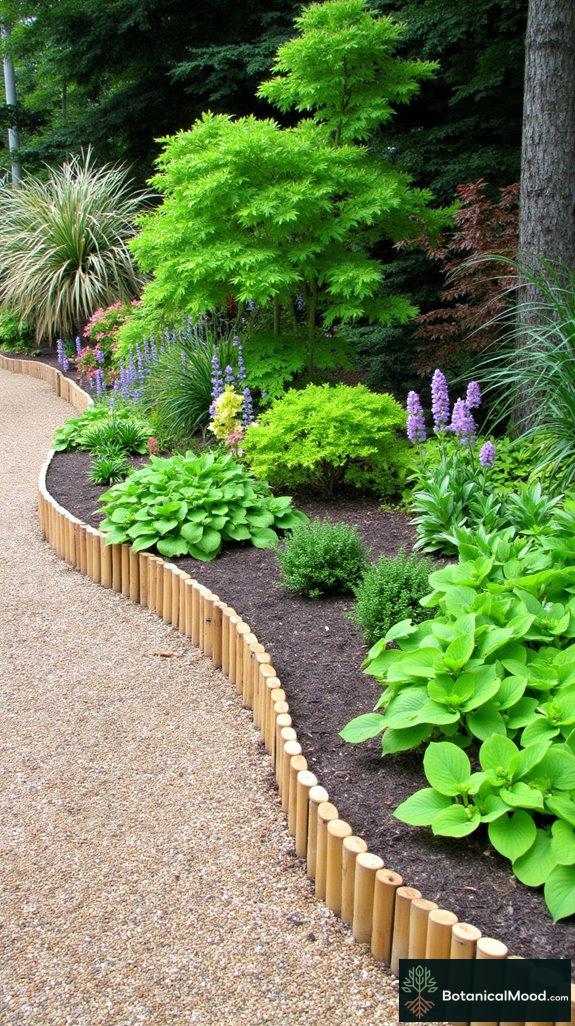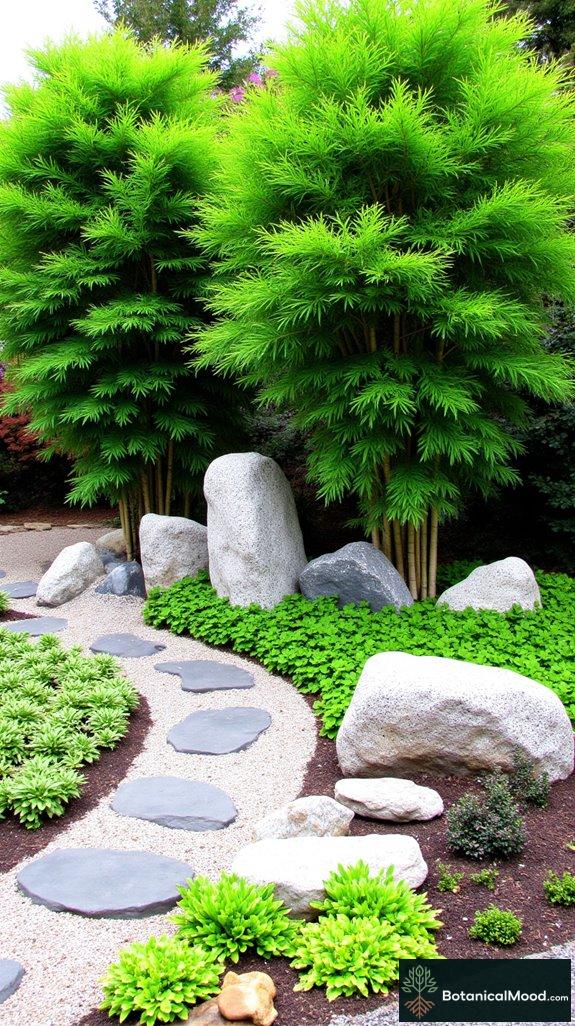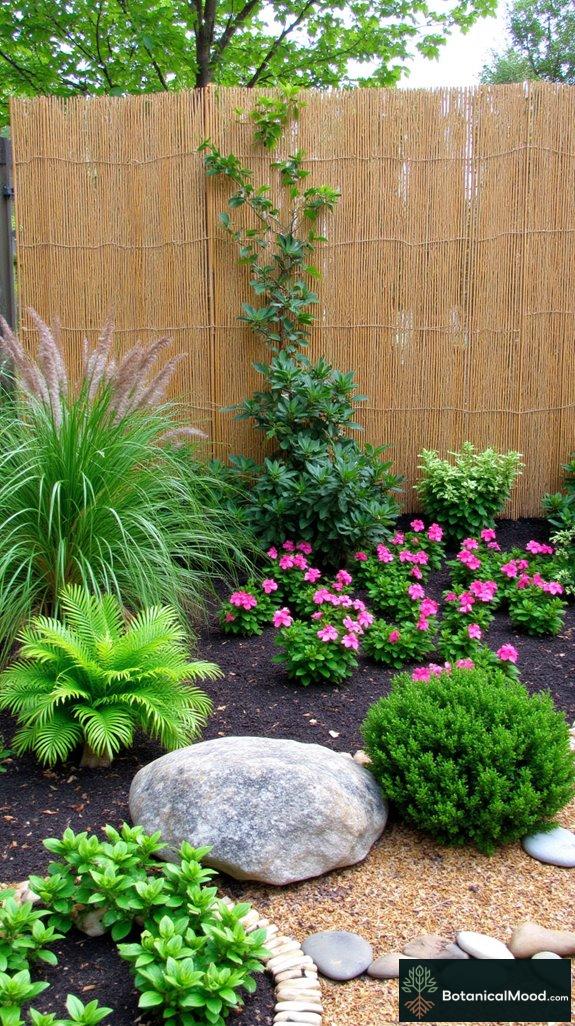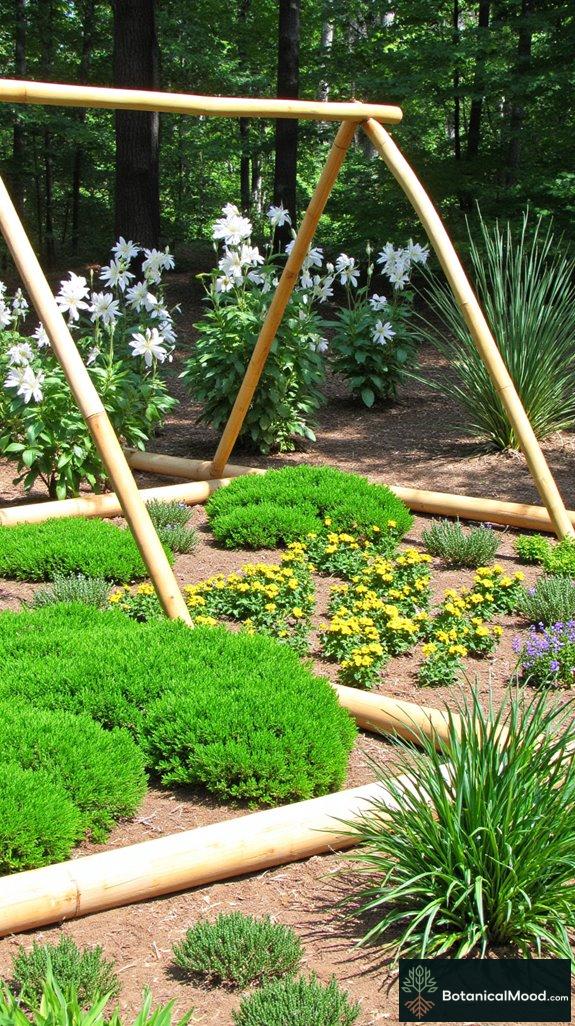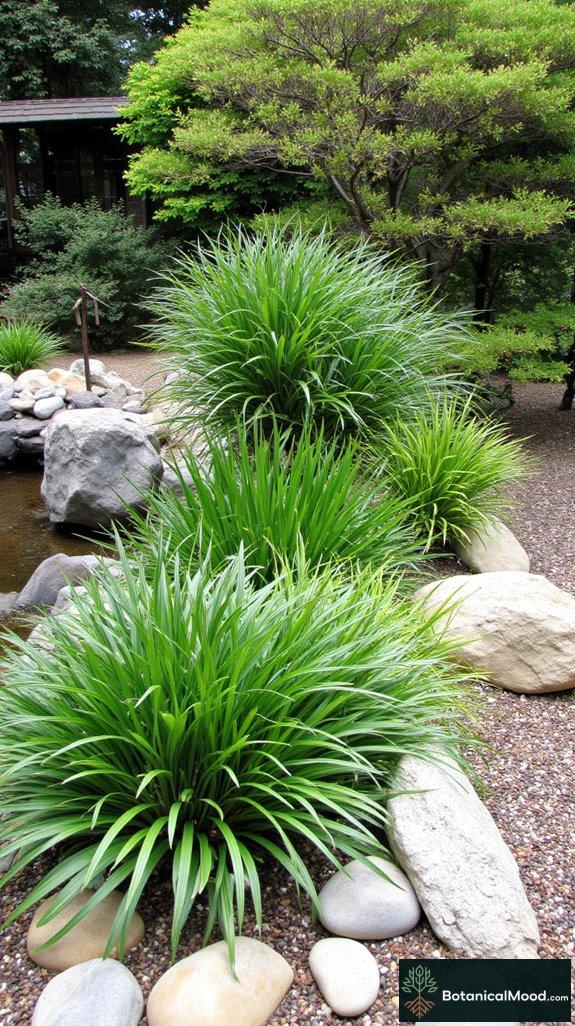Ever stared at your chaotic garden thinking, “This needs a zen makeover“? Trust me, I’ve been there.
I transformed my own backyard disaster into a sanctuary with bamboo borders. Those Fargesia clumpers? Garden lifesavers without the invasive drama.
My favorite setup combines bamboo-lined pathways with mini rock gardens where I pretend to contemplate life (usually just planning dinner).
Adding veggie patches bordered by bamboo gave me structure—and an excuse to tell visitors I’m “cultivating mindfulness” when I’m actually just growing tomatoes.
The shaded seating area has become my escape pod. Sometimes I sit there, bamboo swaying overhead, wondering if plants appreciate irony as much as I do.
How My DIY Bamboo Project Taught Me Garden Patience
Let me share my bamboo disaster of 2019. Armed with YouTube confidence and zero experience, I planted running bamboo without barriers. Big mistake. HUGE.
Six months later, bamboo shoots were emerging in my neighbor’s yard. Talk about awkward HOA conversations! I spent one painful weekend digging trenches for proper rhizome barriers—sweating, cursing, questioning my life choices.
What saved me? Switching to clumping varieties like Fargesia rufa and consulting with an actual landscape designer who kindly didn’t laugh at my original “plan.” The gentle rustling of bamboo leaves now soothes rather than triggers my garden PTSD.
If you’re considering bamboo borders, remember: proper planning prevents plant predicaments. And sometimes admitting you need professional advice is the most zen decision of all.
Quick Takeaways
- Create serene paths enclosed by bamboo, using smooth pebbles and stepping stones for a Zen-inspired ambiance.
- Layer planting beds with taller bamboo and complementary perennials for depth and visual harmony.
- Incorporate minimalistic sculptures or small water features to enhance the tranquil retreat atmosphere.
- Opt for clumping bamboo varieties and use organic mulch to maintain structure while controlling growth.
- Design colorful flower beds surrounded by supportive bamboo to ensure continuous color and interest throughout the seasons.
Tranquil Zen Paths Enclosed by Bamboo

A tranquil Zen path enclosed by bamboo creates a serene retreat in your garden. Ideal sizes range from 4 to 8 feet wide and can stretch along walkways or borders.
Arrange your bamboo in clusters to form natural screens. Popular materials for pathways include smooth pebbles, slate, or stepping stones, while plants like ferns, moss, and ornamental grasses enhance the aesthetic. For an overall peaceful look, consider minimalistic sculptures or a small water feature, which aligns with the principles of modern Zen gardens.
Create natural screens with bamboo clusters, complemented by smooth pebbles, slate, and ornamental plants for a serene aesthetic.
How to Select Plants for Your Tranquil Zen Path
Choosing the right plants is essential for a harmonious Zen garden. Aim for greenery that complements bamboo’s height and texture. Here are some ideal plants:
- Japanese Maples
- Hostas
- Azaleas
- Bamboo (dwarf varieties)
- Sedum
- Ferns
Designing and Planning Your Bamboo-enclosed Zen Path
To create an inviting space, plan your layout with curved paths and varying heights.
Here are tips for designing:
- Choose a Theme – Stick to a color palette, preferably greens and earth tones.
- Spacing – Plant at least 3 feet apart for bamboo to thrive and create a lush backdrop.
- Layering – Position taller plants behind lower ones for depth.
Pro Tip: Use companion planting to attract beneficial insects and minimize pests.
Seasonal Care and Maintenance of Your Zen Garden
Regular watering, seasonal fertilizing, strategic pruning, and monitoring for pests will keep your bamboo-enclosed Zen path healthy and beautiful throughout the year.
Serene Water Features Surrounded by Bamboo

When selecting plants, consider their growth habits and water needs. Here are some recommended plants:
- *Bamboo* (*Phyllostachys* spp.)
- *Japanese Water Iris* (*Iris laevigata*)
- *Golden Club* (*Orontium aquaticum*)
- *Ferns* (e.g., *Athyrium nipponicum*)
- *Creeping Jenny* (*Lysimachia nummularia*)
Designing and Planning Your Serene Water Feature Garden
To design this planting bed, first, sketch a layout that prioritizes the water feature. Use these tips:
- Position taller bamboo on the back to create a layered effect.
- Space plants 12-24 inches apart to allow for natural growth.
- Incorporate stepping stones for accessibility.
- Use curving lines to lead the eye towards the water.
Pro Tip: Mix plants with varying colors and textures for visual interest, ensuring evergreens are included for year-round appeal. Additionally, consider adding enchanted lighting to enhance the ambiance of your water feature garden during the evening.
Seasonal Care and Maintenance for Bamboo Water Feature Gardens
Maintain your garden by regularly watering during dry spells, applying a balanced fertilizer in spring, pruning bamboo in late winter, and monitoring for pests like aphids throughout the year.
Meditative Rock Gardens Framed by Bamboo
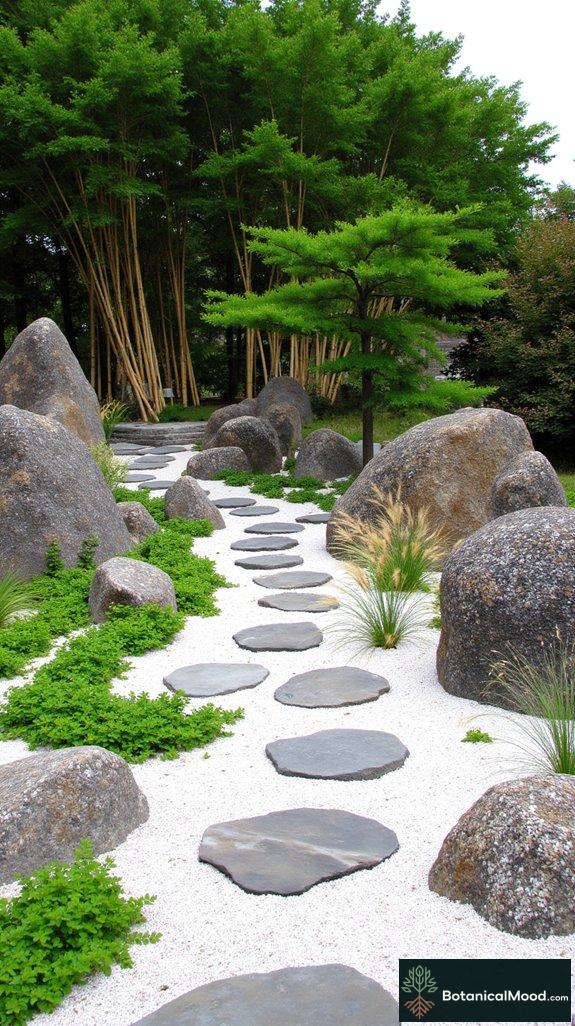
Meditative rock gardens framed by bamboo create serene outdoor spaces, usually ranging from 4×6 to 10×12 feet.
Meditative rock gardens, bordered by bamboo, offer tranquil outdoor retreats, typically sized between 4×6 and 10×12 feet.
These gardens combine textured rocks, white gravel, and carefully placed bamboo, creating distinct zones for reflection. A standard layout features a central stone arrangement surrounded by raked gravel, all framed by graceful bamboo plants for privacy and aesthetic appeal. Natural materials, such as river stones, are ideal for pathways, while bamboo varieties like Fargesia or Phyllostachys give height and structure. Integrating edible landscape strategies can enhance the visual appeal while providing seasonal harvests.
How to Select Plants for a Bamboo-Frame Rock Garden
When choosing plants for a meditative rock garden, opt for those that thrive in limited soil and require minimal watering. Suggested plants include:
- Sedum (stonecrop)
- Sempervivum (hens and chicks)
- Japanese Maple (Acer palmatum)
- Hosta (plantain lily)
- Ornamental Grasses (e.g., Miscanthus)
Tips for Designing a Meditative Rock Garden with Bamboo
Designing this style of garden involves several key steps:
- Plan Layout: Sketch the garden size, design stone placements, and define gravel boundaries.
- Choose the Right Bamboo: Select clumping varieties like Fargesia for close boundaries.
- Plant Arrangement: Place taller plants at the back and shorter ones in the front, ensuring a tiered effect.
- Spacing: Allow 1-2 feet between larger plants and 6-12 inches for smaller ones to promote healthy growth.
- Pro Tip: Consider paths for meditation; use flat stones to create walkable areas.
Seasonal Care and Maintenance for a Bamboo-Frame Rock Garden
Year-round care includes regular watering (more in summer), organic fertilizer application in spring, pruning bamboo in late winter, and monitoring for pests like aphids or spider mites.
Lush Vegetable Gardens Bordered With Bamboo
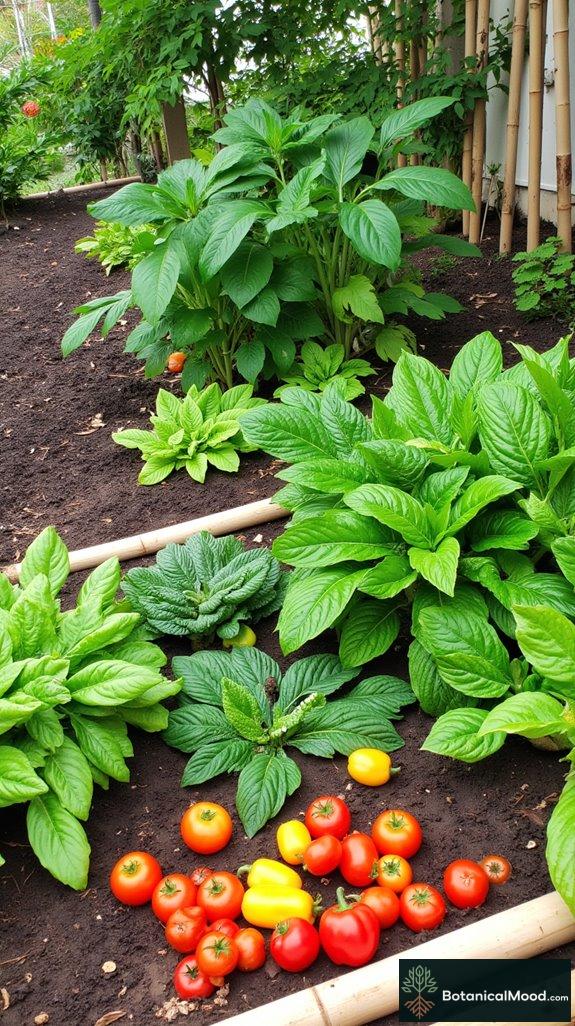
Creating a lush vegetable garden bordered with bamboo offers both aesthetic appeal and practical advantages. A standard planting bed size can range from 4×8 feet, arranged in straight lines for a tidy look. Use bamboo as a natural border to add height and texture while providing a sustainable planting space.
Opt for materials like rich, well-draining organic soil enriched with compost. Popular plants include tomatoes, peppers, and leafy greens, ideally planted in rows for easy maintenance.
Selecting Plants for a Bamboo-Bordered Vegetable Garden
Choosing the right plants is essential for harmony in your bamboo garden. Consider these vegetables that thrive well together:
- Tomatoes
- Bell peppers
- Spinach
- Carrots
- Basil
- Cucumbers
Designing a Bamboo-Bordered Vegetable Garden: Planning Tips
To design an efficient planting bed, follow these tips:
- Layout: Start by sketching your garden using a simple plan.
- Planting Arrangement: Group plants by height, with tall crops on the north side and shorter ones southward.
- Spacing: Space plants 12-24 inches apart for good airflow.
- Pro Tip: Use companion planting to deter pests and enhance growth. For instance, plant basil near tomatoes to boost flavor and repel insects.
Seasonal Care and Maintenance for Your Bamboo Vegetable Bed
Proper care includes consistent watering, organic fertilization during growth spurts, strategic pruning of plants, and regular pest control throughout the year to guarantee a thriving garden.
Unique Sculptural Elements Embraced by Bamboo
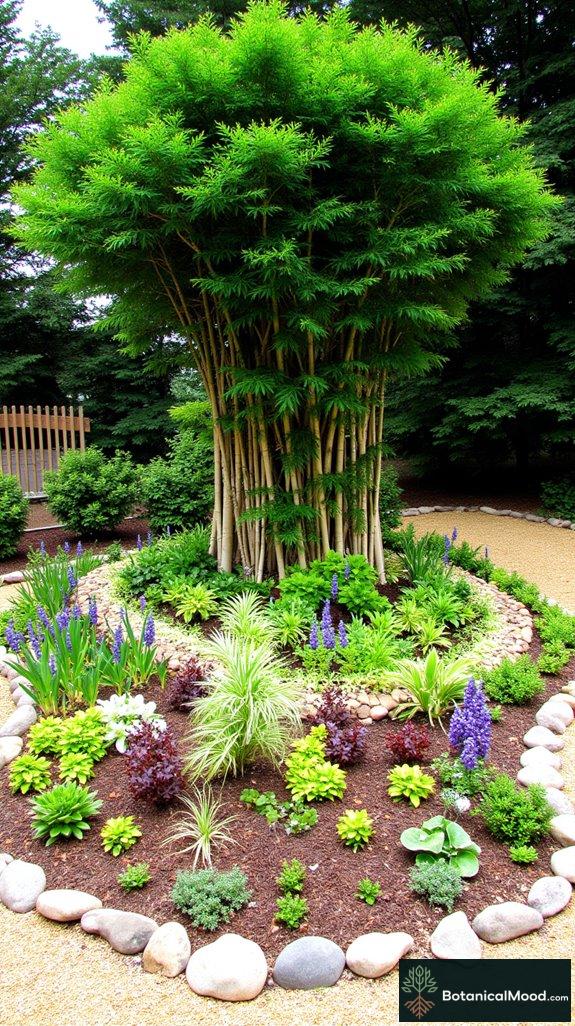
Bamboo garden designs featuring unique sculptural elements create an artistic oasis.
To establish a planting bed, opt for a size of 3-4 feet wide and 6-8 feet long, allowing ample space for various bamboo species and companion plants. Arrange the bamboo at the back, towering majestically in clusters, while colorful perennials like hostas and ferns fill the foreground. Use natural materials like organic mulch or river stones to define the edges.
How to Select Plants for Your Bamboo-Inspired Bed
Choosing plants for a bamboo garden requires compatibility with bamboo’s growth. Consider the following plants:
- Hostas
- Ferns
- Daylilies
- Astilbe
- Sedges
Designing and Arranging Your Bamboo Planting Bed
To design your bamboo planting bed, create a plan that highlights the height and texture of the bamboo while layering adjacent plants.
Here are some tips:
- Space bamboo 2-3 feet apart for air circulation.
- Position taller plants towards the back and shorter ones at the front.
- Create visual interest by varying leaf shapes and colors.
- Align larger stones or driftwood to enhance structure.
Seasonal Care and Maintenance of Your Bamboo Planting Bed
Ensure constant hydration, apply organic fertilizer in spring, prune dead or overgrown canes in fall, and monitor for pests regularly.
Cozy Outdoor Seating Areas Shaded by Bamboo

Creating a cozy outdoor seating area shaded by bamboo involves designing a planting bed that combines functionality with aesthetics. Aim for a bed size of at least 5×5 feet for ample plant growth. Arrange bamboo plants as a backdrop, creating a natural screen, while incorporating comfortable seating. Use materials like stone, wood, or pavers to construct pathways and seating areas.
Choose low-growing plants that complement bamboo foliage, such as ferns, hostas, or shade-tolerant perennials for added color and texture.
How to Select Plants for a Bamboo-Shaded Planting Bed
When selecting plants for your seating area, consider shade tolerance and complementary colors. Here are some plant suggestions:
- Hostas
- Ferns
- Astilbe
- Heuchera (Coral Bells)
- Japanese anemone
How to Design a Bamboo-Shaded Planting Bed
To design your bamboo-themed planting bed:
- Choose the Right Bamboo: Opt for clumping varieties like Fargesia, which are non-invasive.
- Layer Plants: Place taller bamboo towards the back and shorter plants in front.
- Space Wisely: Allow 24-36 inches between clumping bamboo, and 12-18 inches for perennials.
- Use Mulch: Apply 2-3 inches of mulch to retain moisture and suppress weeds.
Pro Tip: Create visual interest by mixing leaf shapes and colors, and guarantee a natural flow by curving your planting beds.
Seasonal Care and Maintenance of Your Bamboo-Shaded Planting Bed
Regularly water to maintain moisture, apply a balanced fertilizer in spring, periodically prune to control growth, and monitor for pests throughout the seasons.
Colorful Flower Beds Accentuated With Bamboo
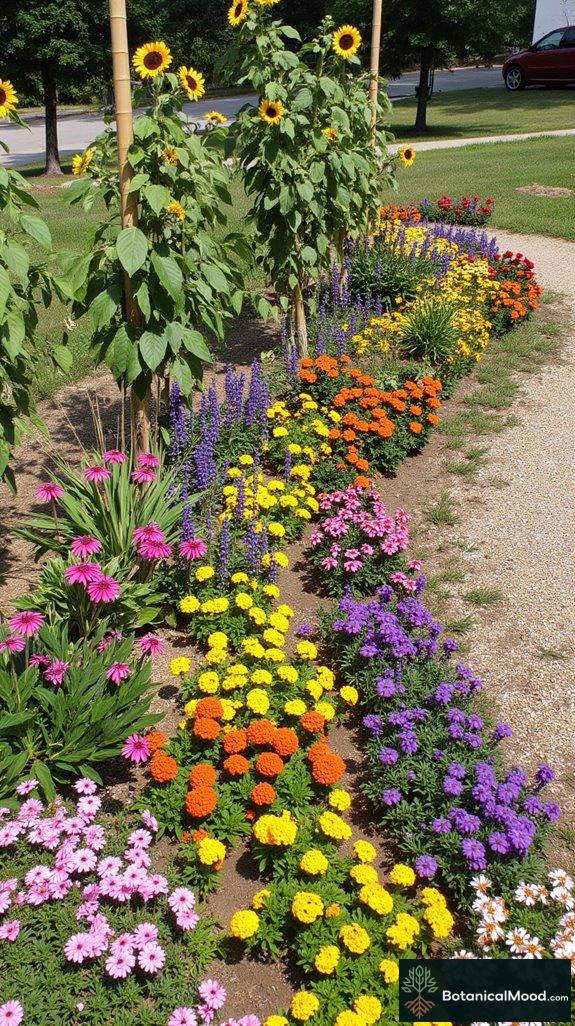
Colorful flower beds accentuated with bamboo create an enchanting space in gardens. Typically sized at 4′ x 8′, these beds feature a symmetrical layout with vibrant flowers surrounded by sturdy bamboo poles. Use a combination of raised beds and borders for visual interest.
Colorful flower beds bordered by bamboo create a magical garden space, blending vibrant blooms with natural beauty.
Plant varieties include petunias, marigolds, and daisies, while materials can consist of organic soil and mulch for nourishment.
Selecting the Best Plants for Colorful Bamboo Flower Beds
When selecting plants for your vibrant flower bed, consider those that bloom at varying times for continuous color. Suggested plants include:
- Petunias
- Marigolds
- Zinnias
- Sunflowers
- Salvia
Designing Your Colorful Bamboo Flower Bed
To design an eye-catching flower bed, follow these tips:
- Choose a focal point, like a larger bamboo structure.
- Layer plants in clusters based on height: tall plants at the back, medium in the middle, and low in front.
- Space plants accordingly — typically 12-18 inches apart for proper air circulation.
- Use contrasting colors for visual impact.
Pro Tip: Create a meandering path through the bed to encourage exploration and engagement.
Seasonal Care and Maintenance for Bamboo Flower Beds
Ensure plants receive consistent watering, fertilize regularly, prune spent blooms, and manage pests throughout the growing season for peak health.
FAQ
What Are the Best Bamboo Species for Garden Borders?
The best bamboo varieties for garden borders include Fargesia murielae and Phyllostachys aureosulcata. I love how these bamboo aesthetics create a lively, liberating atmosphere, transforming my space into a serene retreat that truly inspires.
How Fast Does Bamboo Grow in Garden Settings?
Did you know bamboo can grow up to three feet in just 24 hours? Its rapid growth offers amazing benefits, creating lush, vibrant spaces that inspire freedom and tranquility in any garden setting, including mine.
Is Bamboo Invasive in Garden Landscapes?
Yes, bamboo can be invasive in gardens. I’ve found that certain bamboo types spread aggressively without proper bamboo control. Using barriers or choosing clumping varieties helps me maintain a harmonious and liberated garden space.
What Maintenance Does Bamboo Require Throughout the Year?
You won’t believe how easy bamboo care can be! I tackle seasonal pruning to control growth and keep it healthy. Regular watering and checking for pests throughout the year make all the difference in achieving freedom in your garden!
Can Bamboo Withstand Cold Weather in Gardens?
Yes, bamboo can withstand cold weather with proper winter care. I guarantee they have sufficient mulch for insulation. Some varieties exhibit impressive cold tolerance, so choose wisely to enjoy their beauty even in chillier months!
Summary
I’ve transformed my garden with bamboo, creating a peaceful retreat where tranquility flourishes. From my serene koi pond echoing bamboo rustles to my meditative rock garden inspiring reflection, each element serves a purpose. I’ve cultivated a welcoming space that’s become my haven of peace.
What bamboo designs have you incorporated in your garden? I’d love to hear about your experiences creating zen-inspired spaces and how they’ve affected your daily life.
Share your garden journey with our community! Send photos of your bamboo paradise and tell us about your design process, challenges, and the peaceful moments you’ve enjoyed in your green sanctuary.



